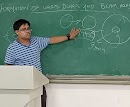Space Exploration
Exited about ISRO's second lunar mission?? Know everything about this amazing mission and spacecraft!!!
Chandrayaan-2 is India’s second lunar
mission. After the success of India’s first lunar mission Chandrayaan-1, Indian
Space Research Organisation (ISRO) decided for a second lunar mission. Chandrayaan-2 will be launched on
July 15. The landing on the moon near the South Pole, an uncharted territory,
would be on Sept 6 or 7. This is the Indian space agency’s most complex mission
so far. The total mission cost is about Rs.63 crore. It will be launched
by GSLV Mk-III rocket of India. Launch cost is estimated about Rs.375 crore.
This is India’s first
mission in which we have orbiter along with a lander and a rover. The life span
expected for orbiter is about 1 year (which may be later expanded) and both
lander and rover has an expected life span of 15 days (which can also be expanded). The wheeled rover will move on the
lunar surface and will perform on-site chemical analysis. The data collected
will be relayed to Earth through the Chandrayaan-2 orbiter. Chandrayaan-2 would make India the 4th country to
soft-land on the Moon, a feat achieved only by the space agencies of the US,
USSR, and China.
Also for latest updates of my posts join me on Twitter
 |
| GSLV MK-III launch Vehicle |
Initially the
ROSCOSMOS (Russian space agency) and ISRO signed an agreement for the two
agencies to work together on the Chandrayaan-2 project. ISRO would have the prime responsibility for
the orbiter and rover, while Roscosmos was to provide the lander. Although ISRO
finalised the payload for Chandrayaan-2 per schedule, the mission was
postponed in January 2013 and rescheduled to 2016 because Russia was
unable to develop the lander on time. Roscosmos later withdrew in wake of the
failure of the Fobos-Grunt mission to Mars, since the
technical aspects connected with the Fobos-Grunt mission were also used in the
lunar projects. This factor played a
huge role in delaying of Chandrayaan-2 mission.
After the withdrawal
of ROSCOSMOS, ISRO along with other Indian research institutes indigenously
developed the orbiter, Vikram lander (named after Vikram Sarabai who is widely
regarded as father of Indian Space Program) and Pragyan rover. The Orbiter High
Resolution Camera (OHRC) will conduct high-resolution observations of the
landing site prior to separation of the lander from the orbiter.
Payload:-
Orbiter payload:
· Large Area Soft X-ray Spectrometer (LASS)
from ISRO Satellite Centre (ISAC), Bangalore
and Solar X-ray monitor (XSM) from Physical Research Laboratory (PRL), Ahmedabad for
mapping major elements present on the lunar surface.
· L and S band Synthetic Aperture Radar (SAR)
from Space Applications Centre (SAC),
Ahmedabad for probing the first few tens of metres of the lunar surface for the
presence of different constituents, including water ice. SAR is expected to
provide further evidence confirming the presence of water ice below the
shadowed regions of the Moon.
· Imaging IR Spectrometer (IIRS) from SAC,
Ahmedabad for mapping of lunar surface over a wide wavelength range for the
study of minerals, water molecules and hydroxyl present.
· Neutral Mass
Spectrometer (ChACE-2) from Space Physics Laboratory (SPL),
Thiruvananthapuram to carry out a detailed study of the lunar exosphere.
· Terrain Mapping Camera-2 (TMC-2) from SAC,
Ahmedabad for preparing a three-dimensional map essential for studying the
lunar mineralogy and geology.
Vikram lander payload:
· Seismometer for studying Moon-quakes near the landing
site
· Thermal probe for estimating the thermal properties of
the lunar surface
· Langmuir probe for
measuring the density and variation of lunar surface plasma
· Radio
occultation experiment for measuring the total electron content
· A laser retroreflector array
(LRA) by NASA Goddard Space Flight Center for
precise measurements of the Earth–Moon distance.
Pragyan rover payload:
· Laser induced Breakdown Spectroscope (LIBS)
from Laboratory for Electro Optic Systems (LEOS), Bangalore.
· Alpha Particle Induced X-ray
Spectroscope (APIXS) from PRL, Ahmedabad.
Thanks for reading.....
Don't forget to check out my other articles and subscribe to this blog!!!
Join me on my social media handles and ask your doubts about the subject freely!!!
See you next time!!!
-Ratnadeep Das Choudhury
Founder and Writer of The Dynamic Frequency












0 Comments